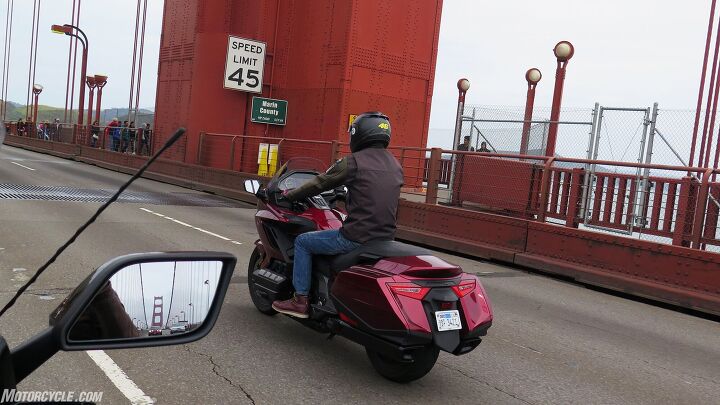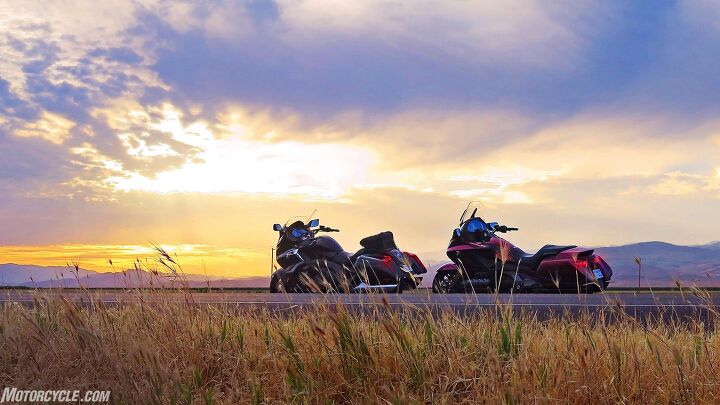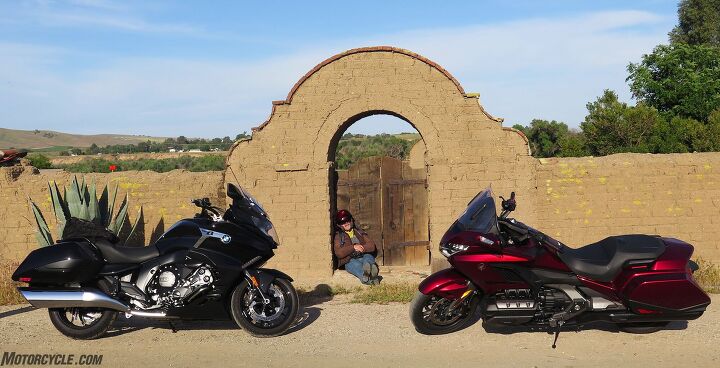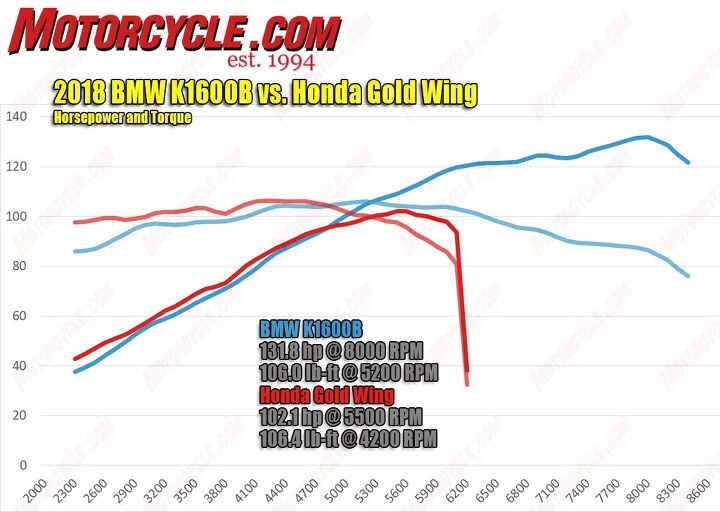|
Motorcycle News - Big Dam Tour Part Due: BMW K 1600 B vs Honda Gold Wing DCT
https://ift.tt/2GsDTvp  When last we left it, in February, the BMW K 1600 B won out over a pack of six other baggers on our overnight whirlwind tour to Hoover Dam, Sin City and parts east. Some didn’t feel the six-cylinder German wonderbike should win since it’s not really a V-twin bagger, but then we’re not really bikers, either, so we just picked the motorcycle we liked best. The BMW was the smoothest, fastest, comfiest, highest-tech two-wheeled vehicle out there that sports saddlebags and a windshield. The shoe that had not yet dropped, however, was Honda’s new 2018 Gold Wing. Now it has. American Honda loaned us a brandspanking red Gold Wing DCT (Dual Clutch Transmission), And so we ride! Instead of seven brosephuses, though, it’s just me and my boy Ryan on a long weekend spin up to Calistoga, an hour or two north of San Francisco in the Napa Valley. A place where it does not suck, and where the Calistoga Half-Mile provided us a near-perfect excuse to explore the area. 2018 Honda Gold Wing Tour Review 
The defending champ is no slouch. The BMW’s bars are a smidge higher than the Gold Wing’s; both bikes are pleasure palaces. Child is now 292 months and 72 inches. From the time I first threw a leg over one of these new Wings at EICMA last November, the reduction in size and weight was apparent, and that’s the number one impression again as we pull away from Door #8 at Honda HQ in Torrance. She’s so small. Honda says the old F6B weighs 844 pounds; this new one tips the MO scales at 806, both of them all gassed up (the new Wing holds 1.1 gallons less – 5.55 gallons). So, the new one’s in fact about 38 or 40 pounds lighter, but it feels like the new ’Wing weighs much less than the old one. It’s still quite a bit heftier than the 768-lb BMW – but both bikes are substantially lighter than all the other “baggers” the BMW beat up on in February. Specs say the new Wing is 0.2-inch longer of wheelbase than the old one, but that’s not how it feels, either. The new double-wishbone front suspension allowed rider and engine to be moved forward on the bike – more over the front wheel and more master of the ship. The grips feel a bit lower than before, which reinforces the suddenly sportier nature of the new bike – and the seat even feels a bit lower; the fact there’s no trunk lets even short people swing into the saddle easily and touch both feet to terra firma. The windshield’s no longer the size of a Buick’s. Now, it’s more of a motorcycle windscreen, and it’s electrically adjustable, too. 
The glove box right there in the middle of the “gas tank” has a foam sleeve for your phone and a USB to plug it into, along with storage for other small items. If it’s an iPhone, Apple CarPlay recognizes and pairs right up to it. The controls in the middle don’t work when the bike’s in motion; you need to use the buttons on the left grip when you’re underway to adjust your navigation and communications. (Or like me, ignore them.) Have the fob in your pocket or the bike’s glovebox, turn the ignition knob to the right, hit the starter and oh, what a nice low racket burbles from the dual exhausts as the six horizontally opposed 73mm pistons swing into action and the seven-inch TFT display puts on its little welcoming ceremony. Hit the little D rocker, for Drive, with your right thumb (shouldn’t it be R for ride?) and off you go. I think the DCT works better as the engine warms up, or is that just me? When you ride off cold, it sometimes feels a bit jerky as it automatically shifts back and forth through the ’Wing’s seven speeds, but it seems to smooth out as the oil warms up. Alternatively, it might just be your human software acclimating to the DCT? After riding the bike for a few days, my right hand seemed to know just how to treat the throttle to make the bike shift or not, and I don’t notice anything anymore except that it’s nice not to have to shift most of the time. I love it. My son still doesn’t like DCT, still insists it’s jerky after more than a few days riding it. My friend Dennis Smith, who’s been riding and racing motorcycles since gas was a dollar, loves his new Gold Wind Tour DCT. There’s an ECON mode, which is pretty lazy and has low-rpm shift points, TOUR is as the name implies. I first toggled into SPORT mode after filling up with gas in Santa Barbara, and when I twisted the throttle in the usual fashion, I nearly wheelied out of the gas station. SPORT makes a big difference in how the bike reacts; it’s much, ahh, sportier. 
The Gold Wing does all that with only 10.5:1 compression and runs fine on Regular. The BMW remains awesome, its 12.2:1 motor wants 89 octane at least. The Beemer does have a big hp advantage, but not really until you achieve Go Directly to Jail speeds. We couldn’t get our DCT ’Wing to run on the dyno, but our man John Ethell at Jett Tuning, in Camarillo, ran a six-speed a couple months ago. In Tour mode, that one made 93 pound-feet of torque as soon as the dyno regained its senses and started recording, at just 1900 rpm. In Sport mode, it’s making 97 at that engine speed, on its way to breaking 100 lb-ft at just 2400 rpm, and a peak of 106 at 4500 rpm. Your big twins in some other touring bikes make that kind of torque at around 2800 rpm, before maxing out at around 75 horsepower at 4500 rpm or so and toddling off to bed shortly after. The big Honda Six hauls drum to 101 horses at 5500 rpm and runs into its rev limiter at 6200 rpm. I think it’s safe to say the new Gold Wing engine is the production bike torque king of all time. It does more before 2000 rpm than most bikes do all day, and you get the impression there’s plenty of room to expand its capabilities. 
A lone 50mm throttle body feeding 1833 cc keeps intake velocity high to produce ridiculous low-rpm torque and instant throttle response. The BMW posts an identical torque peak,106 lb-ft, but it doesn’t get there till 5200 rpm. Horsepower-wise, it buries the Honda, 132 at 8000 rpm to 101 at 5500 rpm, but the BMW remains a little slow on the draw below 3000 rpm, and by the time its rider knows there’s a race on, the Honda has scooted off into the distance. Really, engines are the biggest example of what a contrast in style these two bikes are. One’s an American hot rod from Japan, if you will; the other’s a Ferrari. The BMW would win on a closed road course, and with its greater horsepower should beat the Honda in a quarter-mile. But with the Honda’s tremendous low-rpm grunt (the ’Wing’s got 1833 cc to the BMW’s 1649) and computer brain shifting the zero-lag DCT, you might need Ricky Gadson skills on the BMW to do it. With clear road, it’s a blast (literally) to pin the ’Wing from stops, watch the tach needle bounce between 4500 and 6000, and hang on as the DCT rockets the bike through the gears. Sadly, the rocketing stops at 110 mph and 4000 rpm in sixth, thanks to the bike’s top speed limiter. It’s always something. 
All the Honda’s info is easier to read than the BMW’s, especially its big 7-inch TFT screen. Be sure to take California Highway 25 when you’re out that way. Meanwhile, the BMW’s six-speed shifts great, it’s a magnificent motor once you’re rolling, and its quickshifter takes out most of the work (it still requires too much pressure for downshifts). But using the ’Wing’s DCT paddles in the tight stuff is Formula 1 tech, man! You really can’t leave the Honda in Sport mode all the time, though, because then the bike wants to downshift too early and often. It’s like Shinya Nakano programmed it at Suzuka. The best thing to do when you’re trying to make time on curvy roads is select Sport, and also push the little M that gives you manual control. Then you decide when to make instant up and downshifts with your left forefinger and thumb. (Until I got used to the paddles, I couldn’t figure out why I kept downshifting every time I wanted to honk the horn at a creeper in the fast lane? The horn’s nice and loud when you can find the button.) The paddles also respond even when you’re not in M mode, just in case you’re dawdling along in Econ and suddenly want a burst of speed. Mostly you wind up riding in Tour, which is almost as quick as Sport. 
Note how close the front tire is to the engine now that the tire moves straight up as the suspension strokes. Dual radiators are stuck in the sides behind the Honda badges and are vented outward; I didn’t feel any heat from them or the engine. The BMW heats up your right foot when you’re flogging it. What the mode button doesn’t do on the Gold Wing, that it does do on the Gold Wing Tour, is also adjust suspension damping. The non-Tour ’Wing does not have electric preload or active suspension. Other things it doesn’t have are Honda Selectable Torque Control, a center stand or heated seats. Why a bike this torquey has no HSTC is a question that needs more investigating, and I’m glad I didn’t land on my ear before I realized I was relying on my own skills. Nobody much allows that anymore. The suspension serves up a great ride anyway, with 4.3 inches of travel up front and 4.1 in back, but that great ride has to do it all, from freeway snoozing to backroad bombing, and so it’s slightly compromised everywhere. You’d never really notice, though, if you weren’t riding it alongside the BMW, where the touch of a button takes you from ROAD and quite sporty, to CRUISE, which is as soft and cuddly as your favorite couch. You can adjust the Honda’s rear preload if you’ve got a tiny hand to reach into the adjuster’s cubbyhole ahead of the right saddlebag. The list price on our BMW, which comes with just about every available option including electric suspension, is only $185 more than the Honda. Still, neither of us complained about the Honda’s ride. With its lower roll center and whatever effect a heavy longitudinal reciprocating mass has on a motorcycle, the ’Wing needs more input to make quick direction changes, but it always feels perfectly planted to the road and highly “confidence inspiring,” to trot out a favorite cliche. The new front end means there’s more weight on the front contact patch, and the Gold Wing locks onto whatever lean angle you place it at and stays there as if laser guided until you direct it elsewhere. I love that feeling, Ryan did not: He much prefers the BMW’s lighter, quicker big-sportbike feel. 
The BMW is lighter by a good margin, but it just looks more bulbous than the Honda, like it’s pushing a bigger fairing, no? In tight curves, I loved putting the Honda in Sport mode and using its sportier ergonomics and paddle shifters to shove its nose into corners, then blasting out using its awesome low-rev torque (blissfully unaware without benefit of traction control). The kid thought the Honda was too much like work; he liked the BMW’s quick reflexes and didn’t mind keeping its revvier engine spooled up a bit more. We both agreed the Honda’s got the superior brakes. Both bikes use their no-fork front ends to reduce dive and stop really hard; the Wing just has a bit more feel – and again, a lower center of gravity. In faster curves, the Gold Wing will begin dragging its footpegs sooner than the BMW, but you’re going pretty hard when that happens – and we hadn’t yet found the rear preload adjuster to give it more clearance. Back in town, even though the Honda is heavier, its low cg means it’s slightly easier to pick up off the sidestand and roll around on to the taco truck or Trader Joe’s. When you come back out, though, you’ll be bummed that the Honda’s bags don’t hold as much stuff as the BMW’s. They still hold enough, and all you do to open them is push a little black button. Handy. 
The ’Wing bags won’t hold a helmet, but it does come with a cool attachment deal that will lock a pair to the bike (if your helmets have D-rings). You can get a helmet in each BMW bag, which might be inferior if the bags are already full of other stuff. In fact, the whole ’Wing experience including the way it looks from behind reminds me of a big scooter/Pacific Coast mashup. Though our scales say it’s not that much lighter, it just never feels anywhere near as massive as the GL1500 I did the Iron Butt on in the early ’90s, or the later GL1800 – neither of which could ever do better than 34 miles per gallon. Back and forth to Calistoga, the new bike averaged 41 mpg to the BMW’s 39 mpg. 
There’s a big knob/joystick just off the bottom of this pic that makes entering info into the computer a snap, but you have to mostly use the little buttons on the left handlebar when you’re moving (which are backlit thank God). The big 7-inch screen and advanced Nav system can plot the shortest route to your destination or the fastest one. You can choose to avoid expressways, tunnels, toll roads and ferries. But if you want Dynamic Route Guidance (which sounds like exactly what we want!), you’ll have to “consult your dealer for details.” Apple CarPlay finds your iPhone without even being asked. There is no escape… They’re both great for passengers on short hops, thanks to the low seats and lack of top box; for longer journeys, the BMW’s got better grab handles, which are also better for cargo nets. Both windshields, as delivered, are blustery but not as blustery as the other baggers on the market… At the end of the ride it’s a tough call. It’s like Chrissy Rogers said the other day, “I’d like to get in the hot tub, but I’m too comfortable to get off the couch…” I love the new ’Wing, really I do. Its user interface, mostly that 7-inch screen, is far superior to the BMW’s fine print, and like I may have already repeated more than once, I dig its lowrider/big-scooter feel, low-rpm whomp and shiftless nature. On the other hand, its lack of what’s almost considered basic tech on a motorcycle in this price range – especially since the Tour version comes with active suspension and Honda Selectable Torque Control – leaves me scratching my head (the Gold Wing Tour DCT starts at $27,700). In any case, the MO Scorecard does not lie, and on there, you’ll note that the BMW retains its crown both Objectively and Subjectively (but mostly Subjectively because Ryan marked it down mercilessly for its DCT, handling and smaller bags – two of three things I most liked about it). All the experts in the Comments section say you should never buy a first-year new model anyway. After Honda develops this one a year or two, y’all better stand back. Until further notice, though, the BMW K 1600 B remains the bagger of choice. I’d buy the Honda though. Wait, no, it’s the BMW.
Motorcycles via Motorcycle.comMotorcycle.com https://ift.tt/Xzx9iy May 18, 2018 at 12:13AM Leave a Reply. |
�
Categories
All
Archives
November 2020
|
|||||||||||||||||||||||||||||||||||||||||||||||||||||||||||||||||||||||||||||||||||||||||||||||||||||||||||||||||||||||||||||||||||||||||||||||


































 RSS Feed
RSS Feed

5/17/2018
0 Comments